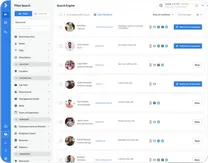
Sales prospecting is really about being smart and precise in finding new customers. It’s not just about trying everything and hoping for the best. Instead, it’s like being an expert archer who knows exactly when and where to aim for the best shot.
The key here is to focus on finding and reaching out to the right people who might actually be interested in what you’re selling. This approach is popular among businesses that are looking to grow because it increases the chances of turning potential leads into actual customers.
In today’s competitive market, having a plan like this is more important than ever. So, let’s check out some prospecting in sales examples that show how it works and why it’s so effective. Let’s get started!
What is Sales Prospecting?
Sales prospecting is the process of identifying and connecting with potential customers who match your ideal client profile. This important step marks the beginning of the sales cycle.
Moreover, sales teams focus on targeted outreach to build new business connections. The aim is to guide these identified prospects through the sales funnel, transforming them into loyal customers.
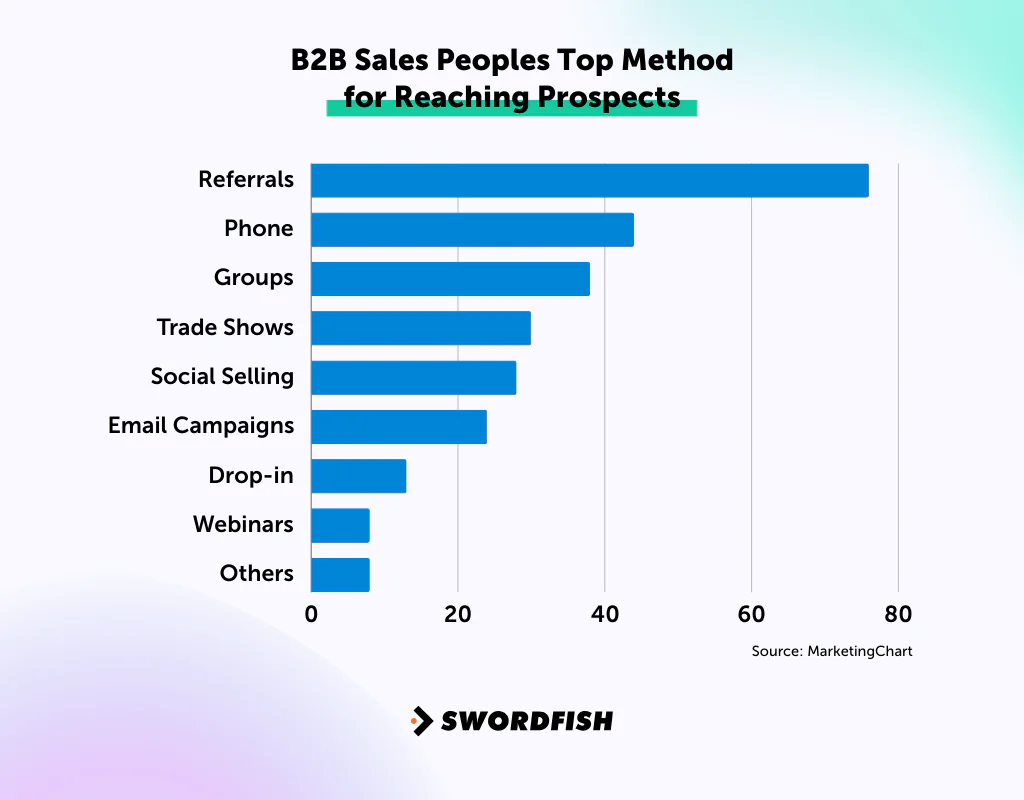
This method is not just about finding leads, but it’s about finding the right leads. A recent study revealed that effective sales prospecting can increase deal closure rates and if you add 20, 30, or 45 minutes to each call, it can be a success.
Don’t forget to take a 5-minute break, though, between each call.
Well, more benefits to sales prospecting include a more efficient sales process, higher conversion rates, and, ultimately, increased revenue. You can use email campaigns, webinars, referrals, social selling, and more as well.
Outbound Vs Inbound Prospecting: What’s the Difference?
Now, understanding the details between outbound and inbound prospecting is crucial for forming a great strategy. Let’s see:
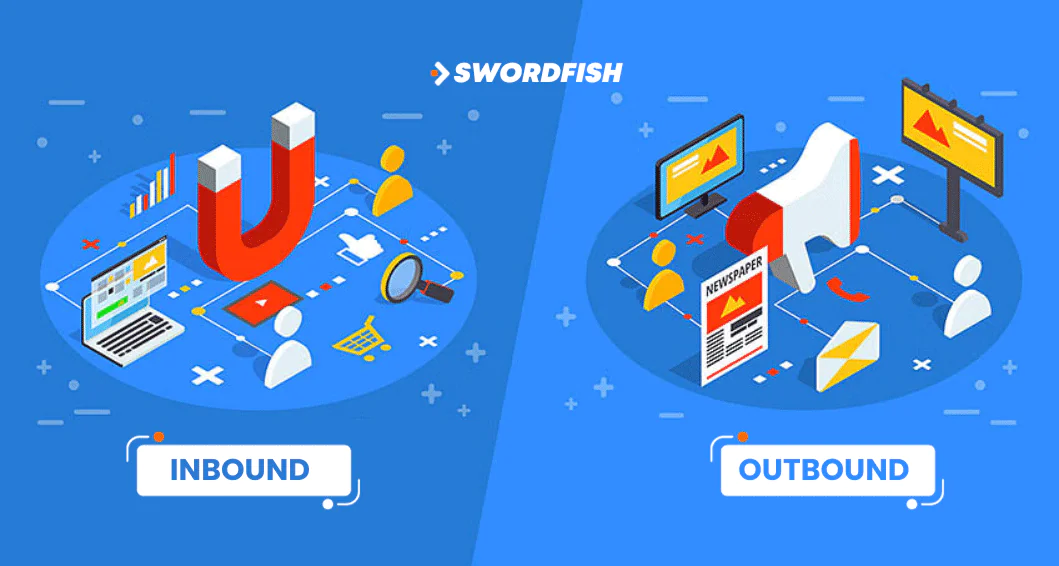
Outbound Prospecting
This approach is about taking the initiative to reach out to potential customers who may not yet be aware of your products or services. It’s a proactive method that demands techniques like cold calling.
According to RAIN Group, up to 82% of buyers accept meetings with sellers who proactively reach out. Cold emailing and social selling are also key components, allowing sales teams to engage with prospects directly.
Therefore, this method is particularly capable of creating awareness and sparking interest among new market segments.
Inbound Prospecting
In contrast, inbound prospecting is about drawing in leads who have already shown some level of interest in your brand. This interest is often cultivated through digital marketing efforts.
Plus, it includes examples of prospecting in marketing content, SEO, and social media marketing, etc.
For instance, HubSpot reports that SEO leads have a 14.6% close rate that’s higher than outbound leads. Inbound prospecting capitalizes on this interest, which nurtures leads through informative and engaging content and guides them further down the sales funnel.
This method is very effective in building trust and credibility, too, leading to higher conversion rates.
Importance of Sales Prospecting
Sales prospecting is more than just a step in the sales process. It’s the foundation for sustainable business growth. Let’s find its significance:
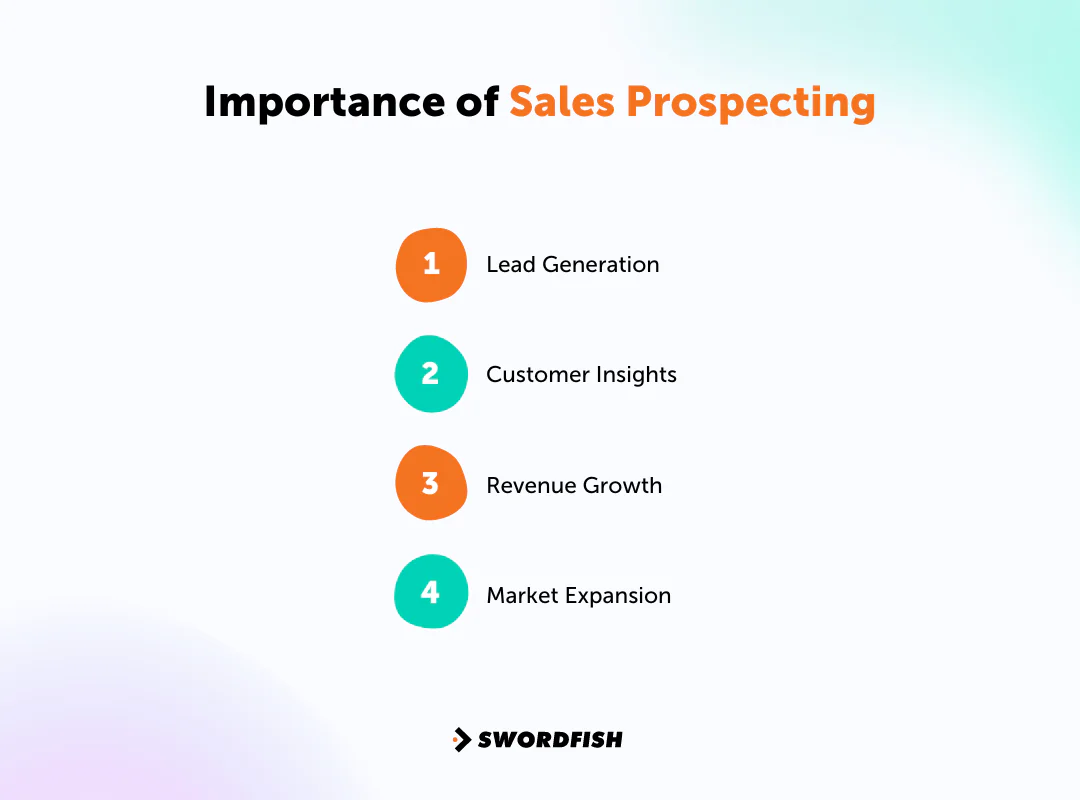
Lead Generation
The lifeblood of any sales operation, prospecting efficiently builds a robust pipeline of potential customers. It’s not just about quantity but quality.
According to studies, high-quality lead generation is considered the top priority by most professionals, underscoring its importance in sales.
Customer Insights
This process offers a deep understanding of customer needs and preferences. Engaging with prospects provides real-time feedback and trends, which is essential for tailoring products and services to meet market demands.
Revenue Growth
Turning prospects into customers is directly linked to an increase in revenue. A well-executed prospecting strategy can remarkably boost conversion rates. In fact, companies with strong sales and marketing alignment see a 20% annual growth rate, according to Aberdeen Group.
Market Expansion
Prospecting is instrumental in identifying new market segments and expanding a business’s reach. It allows companies to tap into unexplored territories and demographics, which leads to growth and diversification.
How to Build a Perfect Sales Prospect Strategy
Building a successful sales prospecting strategy is a structured process that requires careful planning and execution. Here’s a quick guide on how to develop an amazing prospect strategy:
Identify Your Ideal Customer Profile (ICP)
Start by defining who your ideal customers are. This covers analyzing demographic, psychographic, and behavioral characteristics to create a detailed profile.
Plus, understanding your ICP helps in targeting the right audience and reducing the time and resources spent on unqualified leads.
Utilize Various Prospecting Methods
To enhance the effectiveness of your sales prospecting strategies, it’s important to use a variety of methods. One such technique is cold emailing, which can be particularly effective in B2B industries.
In fact, HubSpot reports that cold emails in these sectors have an average open rate of 38.49%.
This means social selling and networking at events are also necessary. It’s because they allow for more personalized interactions and relationship building.
Use Technology
Implement CRM systems and data analytics tools. These technologies organize the prospecting process, providing valuable insights and automating routine tasks.
For instance, companies using CRM software have seen sales increase by up to 29%, according to Salesforce.
Personalize Your Outreach
Customize your communication to align with each prospect’s specific needs and interests. Personalized emails, for example, deliver higher transaction rates than non-personalized ones.
Follow-Up Strategically
Develop a systematic follow-up approach. This could have a mix of emails, phone calls, and social media engagement to keep prospects interested.
Remember, 2% of sales happen in the first meeting and 80% of sales require five follow-up calls after the initial contact, as reported by Marketing Donut.
Measure and Adjust
Regularly assess the effectiveness of your prospecting efforts. Use metrics like response rates, conversion rates, and ROI to gauge success. Adjust your strategies based on these insights to continually improve your prospecting outcomes.
Top 10 Examples of Prospecting for Fruitful Sales Results
Successful sales prospecting is a multifaceted approach, incorporating various strategies to reach and engage potential customers. Here are five key examples, each with practical applications:
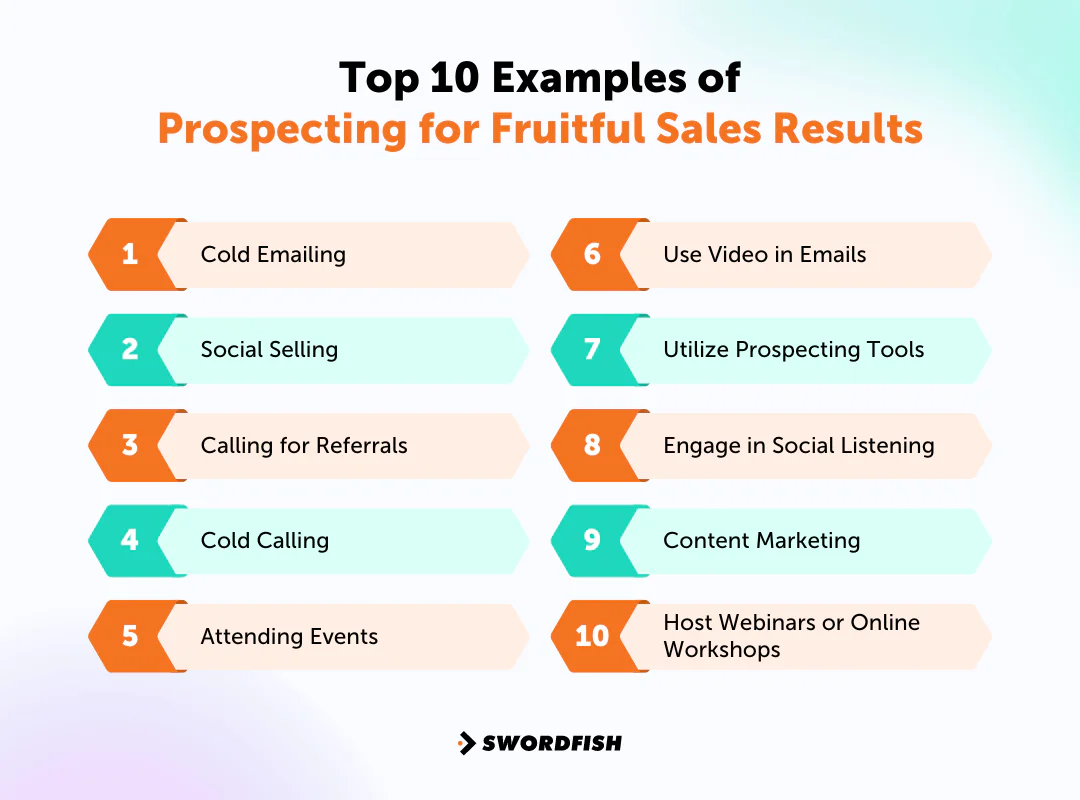
1. Cold Emailing
This requires sending personalized emails to potential leads with no prior interaction.
For example, a software company might send emails to IT managers that highlight how their product can streamline workflow. The key is to tailor the message to address specific pain points or interests of the recipient.
Believe it or not, this actually increases the likelihood of engagement.
Template:
Subject: Streamline Your IT Workflow with [Product Name]
Hi [IT Manager’s Name],
I noticed your company is growing rapidly. Our software, [Product Name], can help streamline your IT operations, making your team more efficient. Would you be open to a quick chat about
2. Social Selling
This modern technique uses social media platforms to connect with and engage potential customers. For instance, a digital marketing agency might use LinkedIn to share insightful content and engage in discussions with business owners.
It subtly promotes their expertise and services.
Template:
Post on LinkedIn:
“Thrilled to share our latest insights on digital marketing strategies. For business owners looking to boost their online presence, these tips could be game-changers. #DigitalMarketing #BusinessGrowth”
3. Calling for Referrals
Well, this strategy demands encouraging existing satisfied customers to refer new prospects. A common example is a fitness center offering a free month’s membership to members who refer a friend who signs up.
The method uses the trust and satisfaction of current customers to attract new ones as well.
Template:
Email to an existing customer:
“Dear [Customer’s Name], as a valued member of our fitness community, your opinion matters to us. If you know anyone who might benefit from our services, refer them and get a free month’s membership when they sign up!”
4. Cold Calling
This traditional method involves calling potential customers directly. A classic example is a real estate agent calling homeowners in a specific area to offer their services.
Plus, this approach should be conversational and aim to understand the prospect’s current needs. Also, it should know how your service can provide a solution.
Template:
“Hello [Prospect’s Name], this is [Your Name] from [Your Company]. I’m calling to discuss how we can assist in enhancing your real estate portfolio. Do you have a moment to talk about your current needs?”
5. Attending Events
Networking in person at events, like trade shows or industry conferences, is a valuable prospecting method. For example, a startup might attend a tech conference to connect with potential investors and partners.
This face-to-face interaction grants more personal connections and immediate feedback.
Template:
At a conference:
“Hi, I’m [Your Name] from [Your Startup]. We’re here to explore partnerships and investment opportunities. Can I tell you more about our innovative solutions?”
6. Use Video in Emails
This requires incorporating videos into your email outreach. For example, a health and wellness company could send personalized video emails to potential clients.
It showcases quick health tips or product demonstrations. This method also makes the communication more engaging and personal.
Template:
Subject: See [Product Name] in Action!
Hi [Prospect’s Name],
I’ve attached a short video showing how [Product Name] can solve [specific problem]. Let me know if you’d like more information!
7. Utilize Prospecting Tools
These tools help in efficiently finding and reaching out to potential leads. For instance, a B2B service provider might use a tool like LinkedIn Sales Navigator to identify and connect with key decision-makers in their target industries. To explore the possibilities and benefits of this tool further, one can delve into the details of LinkedIn Sales Navigator cost.
Plus, it streamlines the prospecting process.
Template:
LinkedIn Message:
“Hi [Prospect’s Name], I came across your profile on LinkedIn. Your experience in [Industry] is impressive. I believe our [Product/Service] could really support your goals. Can we discuss this further?”
8. Engage in Social Listening
This technique involves monitoring social media for mentions of your brand, competitors, or industry keywords. A fashion retailer, for example, could use social listening to find and engage with potential customers.
It’s basically a discussion of fashion trends on platforms like Instagram or Twitter.
Template:
Twitter Reply:
“@[Customer’s Handle] Thanks for sharing your thoughts on [Topic]! Have you considered [Your Product/Service] as a solution? We’d love to chat more about how we can help.”
9. Content Marketing
Now, this strategy focuses on creating and sharing valuable content to attract and engage a specific audience.
An example would be a software company producing in-depth blog posts or whitepapers on industry challenges and solutions. They establish themselves as thought leaders and attract potential clients.
Template:
Blog Post Title: “Understanding the Challenges of [Industry]: A Comprehensive Guide”
Introduction: “In this post, we’ll explore common challenges in [Industry] and how [Your Company’s Product/Service] can offer effective solutions.”
10. Host Webinars or Online Workshops
This one covers educating and engaging prospects through online events. For example, a financial consulting firm could host webinars on investment strategies for small businesses.
Moreover, it attracts business owners interested in financial planning and opening up opportunities for follow-up and engagement.
Template:
Webinar Invitation Email:
Subject: Join Our Webinar on Investment Strategies for Small Businesses
Hi [Prospect’s Name],
We’re hosting a webinar on [Date] about investment strategies tailored for small businesses. It’s a great opportunity to learn and ask questions. Register here: [Link]
Some Pro Tips for Your Prospecting in Sales!
To excel in sales prospecting, you must have a strategic and detailed approach. Here are some tips to enhance your prospecting efforts:
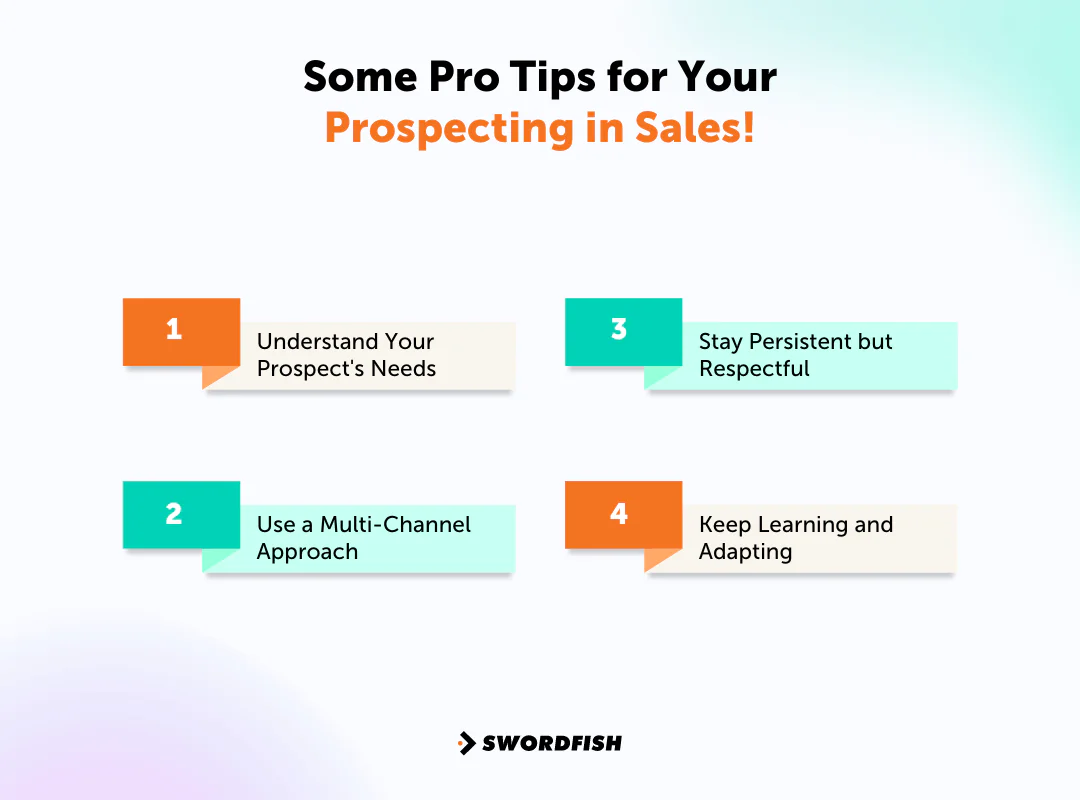
Understand Your Prospect’s Needs
The key to successful prospecting is not just reaching out to potential customers but doing so in a way that resonates with them. This means thoroughly understanding their unique challenges and pain points.
Suppose you’re reaching out to small business owners for prospecting in business. In this situation, use your approach to address common issues they face. There might be limited budgets or a need for solutions that can grow with the business.
Use a Multi-Channel Approach
Don’t rely on just one method of prospecting. Combining different channels, such as email, social media, phone calls, and in-person meetings, can remarkably broaden your reach and increase your chances of connecting with prospects.
For example, you might start with a LinkedIn message, follow up with an email, and then propose a phone call or meeting for more detailed discussions.
Stay Persistent but Respectful
Persistence is key in sales prospecting, but it’s equally important to respect the prospect’s time and decision-making process. This means following up regularly and knowing when to step back.
Research by Rain Group indicates that it often takes at least 8 touches to secure a sale, but it’s crucial to balance this with respect for the prospect’s boundaries.
For example, you might follow up with a prospect after a week after an initial contact. Then, depending on their response, decide whether to continue regular follow-ups or give them more space.
Keep Learning and Adapting
Last but not least, the sales space is constantly getting better. So staying informed about industry trends and adjusting your strategies is very important.
This could involve adopting new technologies, refining your ICP based on market changes, or updating your outreach scripts and templates.
Plus, regularly seek feedback from prospects and customers, and use this information to fine-tune your approach.
Swordfish AI: Fuel Your Prospecting with Precise Contact Information
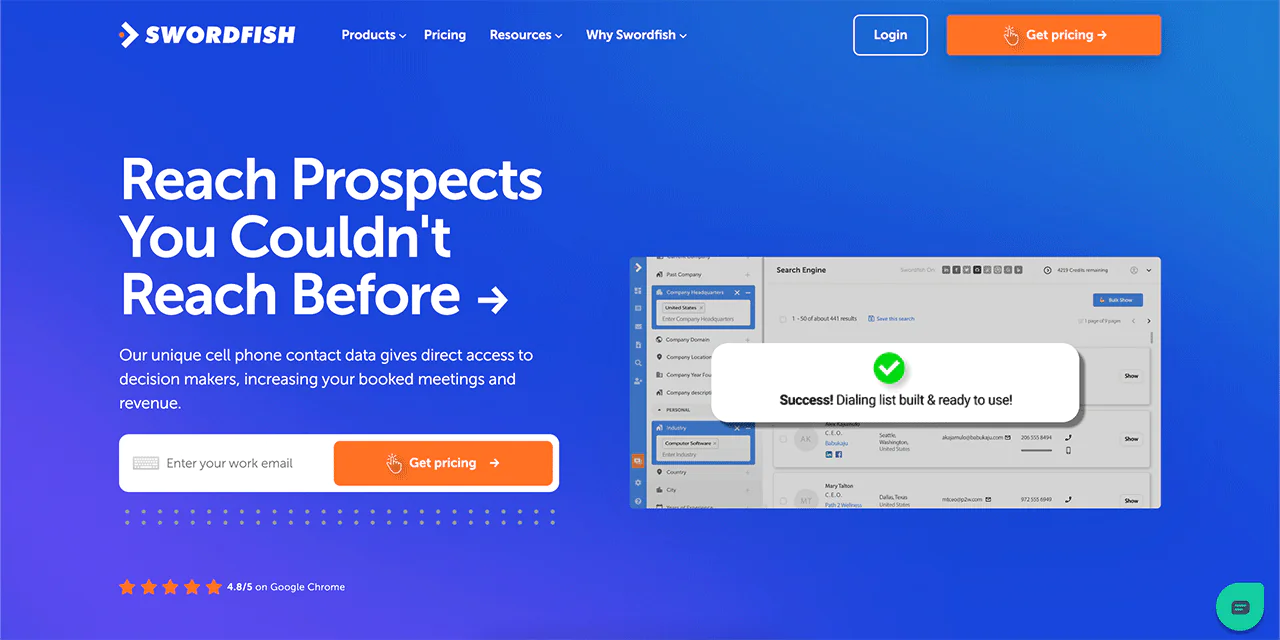
Swordfish AI is a cutting-edge tool designed to revolutionize sales prospecting by providing highly accurate contact data. This platform is essential for sales teams seeking efficient and effective ways to connect with potential clients.
Key Features and Benefits
Here are some features and benefits of this perfect tool:
Accurate Contact Information
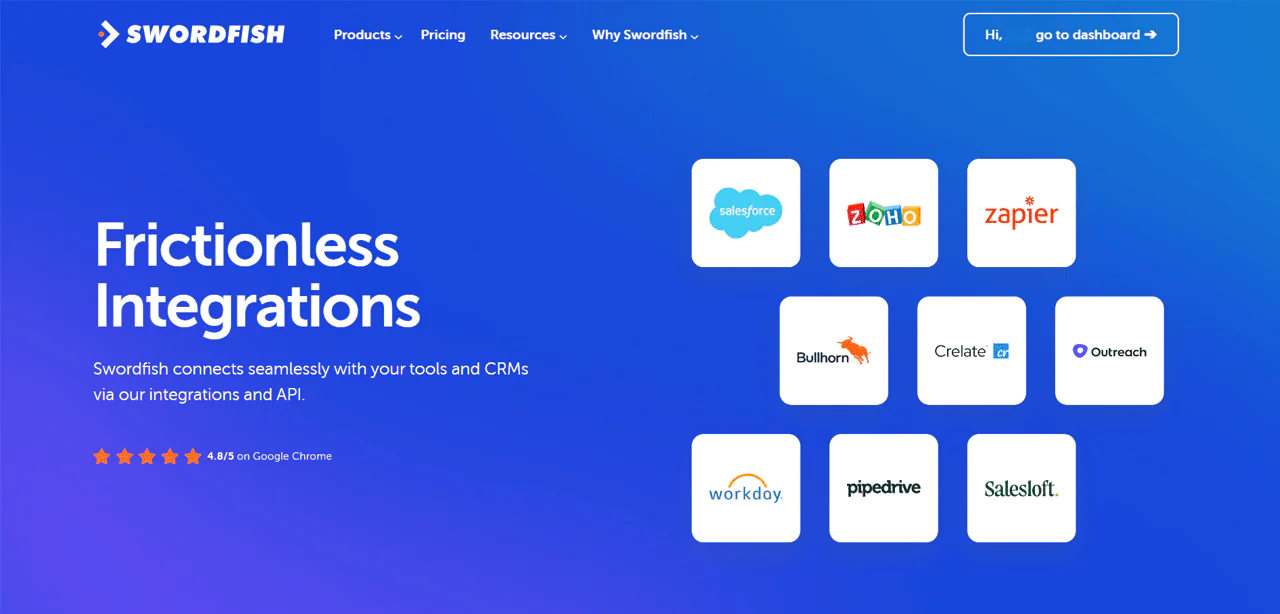
Swordfish AI provides up-to-date phone numbers, email addresses, and social media profiles. This vastly reduces the time spent on incorrect or outdated leads and increases productivity.
CRM Integration
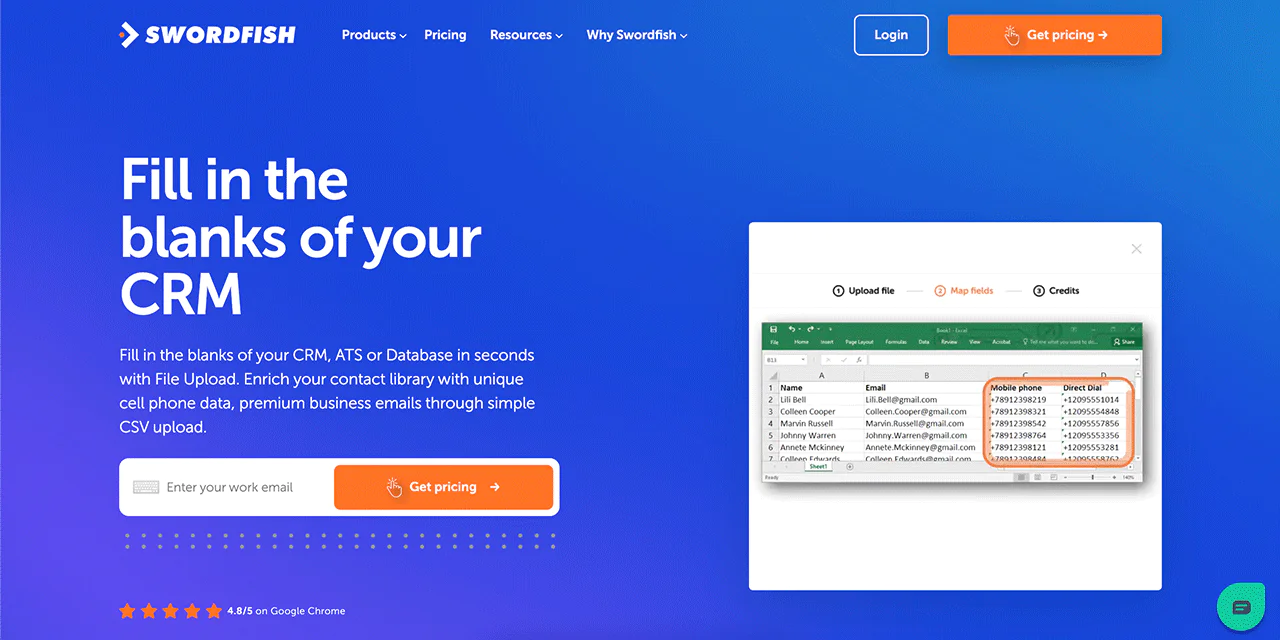
The platform seamlessly integrates with popular CRM systems. This allows for easy import and management of prospect data and maintaining an organized sales process.
Advanced Search Capabilities
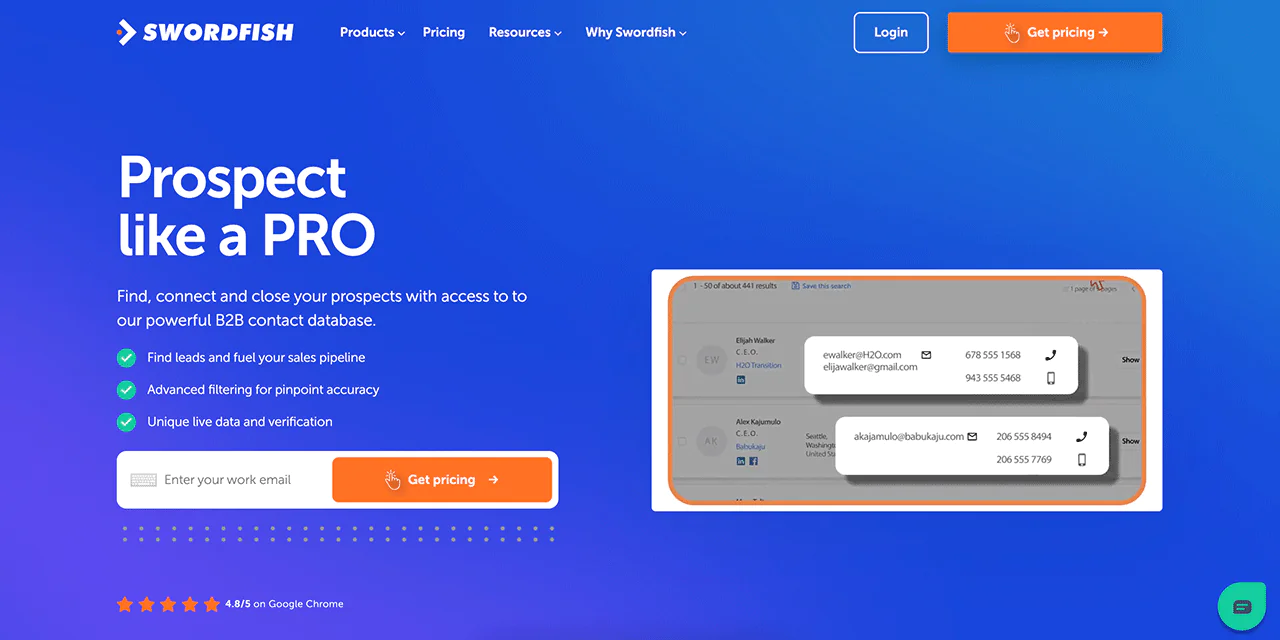
You can use advanced search options to find relevant prospects quickly. This is great for creating strategies for specific market segments. It also helps increase your chances of successful engagements.
Compliance and Data Privacy
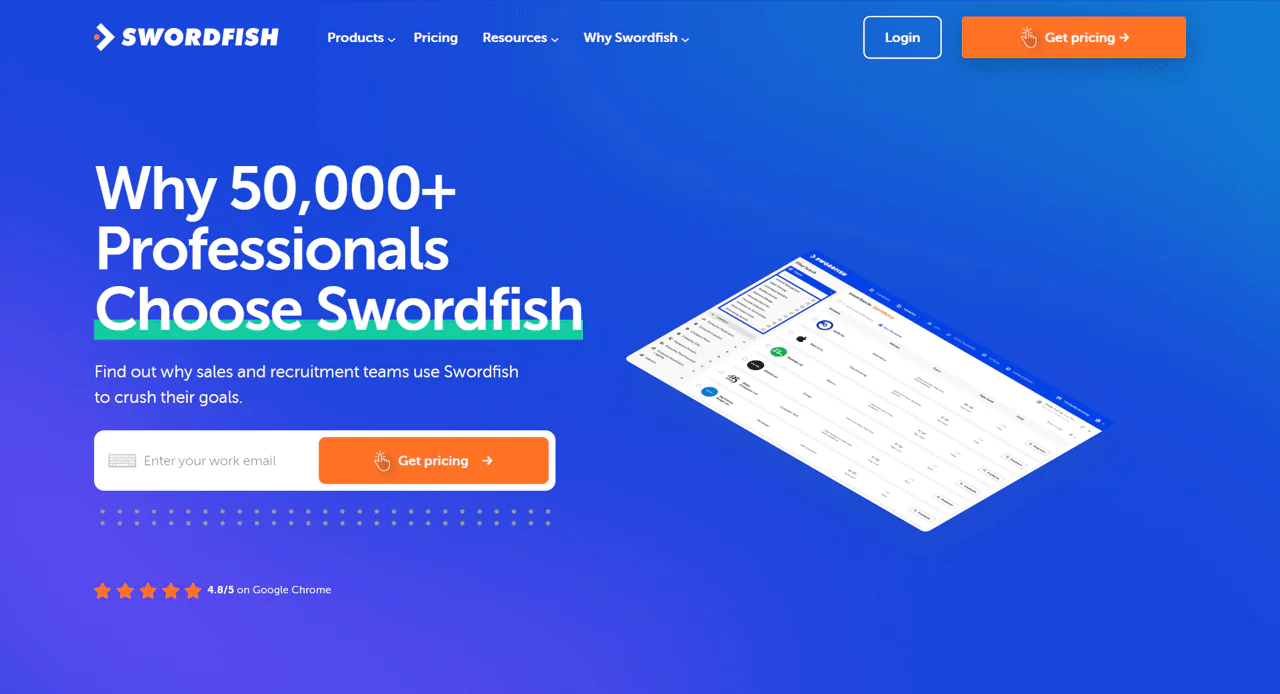
Swordfish AI adheres to the latest regulations in data privacy and ethical prospecting. It makes sure that all user activities are legally compliant and safeguard both the user and their prospects.
Conclusion
In conclusion, we’ve explored various prospecting in sales examples that show us the importance of a tailored and strategic approach in this crucial business process.
As we’ve seen, understanding your prospects and employing a diverse range of techniques is key to transforming leads into loyal customers. Remember, the landscape of sales is ever-evolving, and so should your prospecting strategies.
We encourage you to continuously refine your methods and make sure they align with the changing needs and behaviors of your target market. By doing so, you’ll not only maintain relevance but also drive growth and success in your sales endeavors.
Good wishes!
FAQs
How often should I update my prospecting list in sales?
Regular updates are key for an effective list. It’s advisable to review and refresh your prospecting list periodically. But for the ideal scenario, you can update it every quarter, to ensure relevance and accuracy.
Can automation tools help in sales prospecting?
Yes, automation tools can significantly streamline the prospecting process. They help in managing leads, scheduling follow-ups, and maintaining consistent communication.
What are the challenges of prospecting in sales?
There are challenges in sales prospecting for sure. They include dealing with rejection, finding the right prospects, maintaining persistence, and effectively managing time.

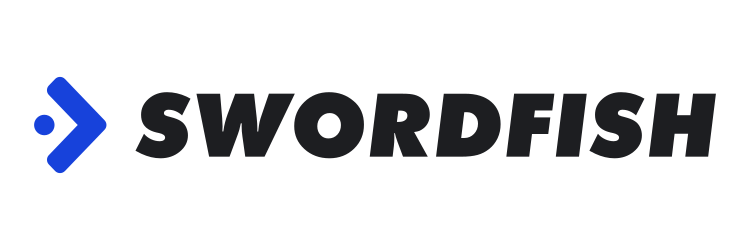
 View Products
View Products


